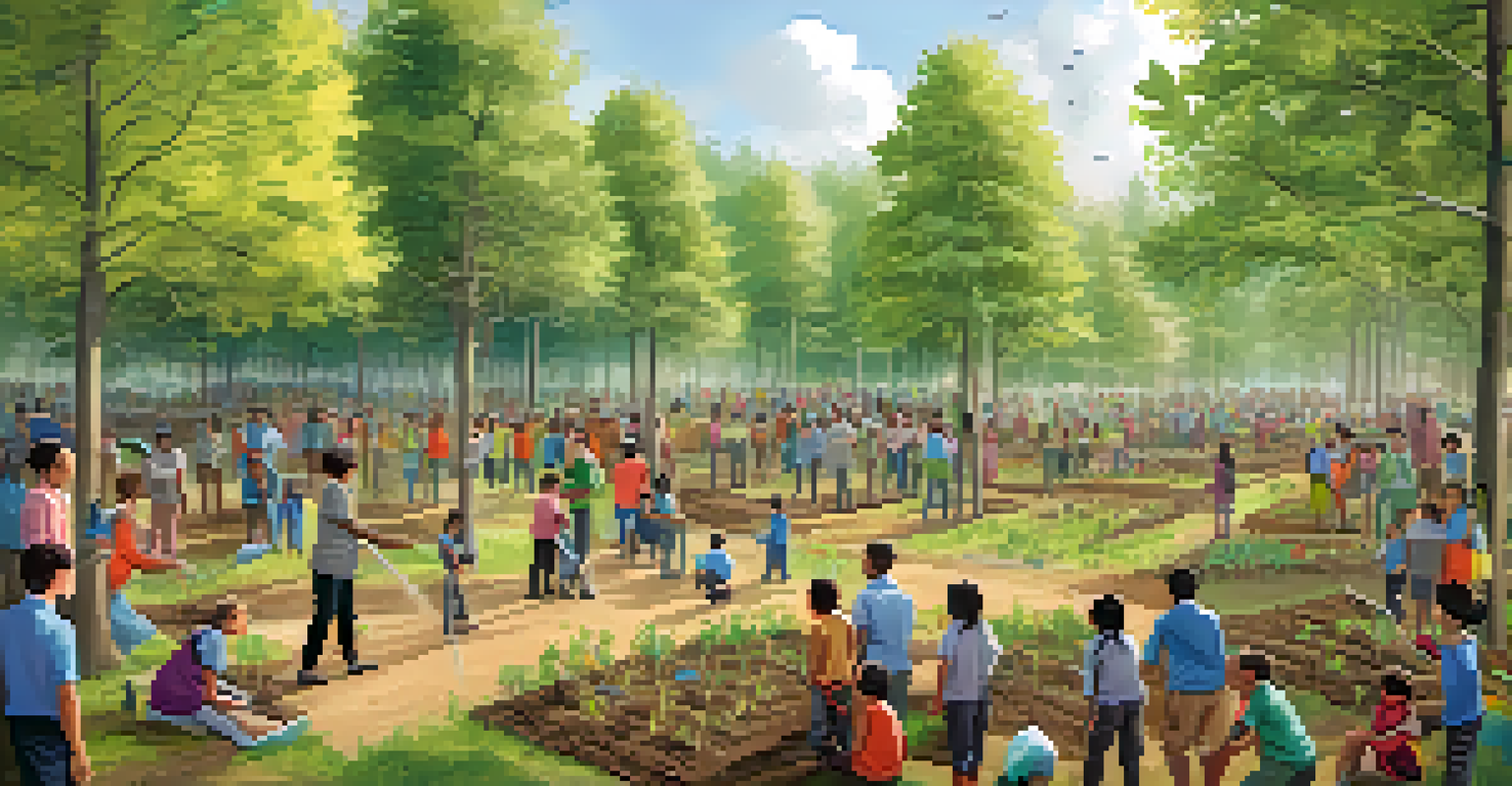Forestry Practices That Promote Sustainable Forest Management

Understanding Sustainable Forest Management
Sustainable forest management is all about balancing ecological, economic, and social factors. It ensures that forests can provide resources like timber and clean air without compromising future generations' needs. Think of it like tending to a garden; if you overwater it or neglect it, the plants won't thrive. Similarly, forests require careful management to flourish sustainably.
The best time to plant a tree was twenty years ago. The second best time is now.
Essentially, sustainable management practices aim to maintain biodiversity, productivity, and the health of forest ecosystems. This involves monitoring wildlife habitats, soil quality, and water resources to ensure a thriving environment. Consider it as conducting regular check-ups for a healthy lifestyle; regular monitoring helps catch potential problems before they escalate.
Additionally, sustainable management involves the participation of local communities and stakeholders. Engaging these groups fosters a sense of responsibility and ownership, contributing to the overall success of forest management strategies. It's like a team sport—everyone plays a role in ensuring the forest remains healthy and productive.
Selective Logging and Thinning Techniques
Selective logging and thinning are practices that focus on removing only certain trees instead of clear-cutting entire areas. This method allows for natural regeneration and minimizes the impact on the surrounding ecosystem. Think of it as pruning a plant; you remove specific parts to help it grow healthier.

By focusing on the removal of mature or unhealthy trees, selective logging promotes the growth of younger trees and maintains biodiversity. This creates a more balanced forest composition, allowing various species to thrive. Imagine a bustling city where not every building is the same height—diversity in tree size fosters a more resilient forest.
Balancing Ecology and Economy
Sustainable forest management harmonizes ecological, economic, and social factors to ensure forests thrive for future generations.
Thinning, on the other hand, involves reducing tree density to enhance growth and reduce competition for resources. This practice can lead to healthier trees and increased carbon sequestration. It’s like giving your favorite plants more space and nutrients so they can flourish!
Agroforestry: Combining Agriculture and Forestry
Agroforestry is a dynamic approach that integrates trees and shrubs into agricultural landscapes, creating a symbiotic relationship between farming and forestry. This practice not only enhances biodiversity but also improves soil health and reduces erosion. Picture a farmer planting fruit trees alongside crops; both benefit from the arrangement.
In every walk with nature one receives far more than he seeks.
By incorporating trees into farming systems, farmers can diversify their income streams while contributing to forest conservation. This method helps mitigate climate change effects by sequestering carbon, similar to how a sponge absorbs water. The more trees, the more carbon they can capture!
Moreover, agroforestry can provide shade and habitat for wildlife, further promoting ecological balance. This approach creates a win-win situation for both agricultural productivity and forest health. It's like having your cake and eating it too—enjoying the benefits of both ecosystems.
Reforestation and Afforestation Efforts
Reforestation involves replanting trees in deforested areas, while afforestation refers to planting trees in non-forested lands. Both practices are vital for restoring ecosystems and combating climate change. Think of reforestation as a way to heal a wound—bringing life back to an area that has been scarred by deforestation.
These efforts not only help restore biodiversity but also improve air quality and provide habitats for wildlife. The process can be likened to a community coming together to rebuild a park—planting trees and native plants revitalizes the local environment. It's a collaborative effort that pays off in the long run.
Community Engagement is Crucial
Involving local communities in forestry management fosters ownership and enhances conservation efforts through shared knowledge.
Furthermore, reforestation and afforestation can enhance carbon sequestration, playing a crucial role in mitigating climate change. By planting more trees, we create a natural solution to absorb excess carbon dioxide from the atmosphere. It's like giving Earth a breath of fresh air, promoting a healthier planet.
Preserving Old Growth Forests
Old growth forests are ancient ecosystems that have developed over centuries, providing unique habitats and critical carbon storage. Protecting these forests is essential for biodiversity conservation and climate regulation. Imagine stepping into a cathedral made of trees; the grandeur and complexity of these ecosystems are irreplaceable.
These forests host a myriad of species, some of which rely solely on old growth for survival. By preserving these areas, we not only safeguard wildlife but also maintain essential ecological processes. It's like protecting a rare, beautiful painting; once it's gone, it can never be replaced.
Moreover, old growth forests play a significant role in water filtration and soil stabilization. They act as natural buffers against climate extremes, helping to regulate local climates. It's akin to having a natural air conditioner, cooling the surroundings while maintaining ecological balance.
Community Involvement in Forestry Management
Community involvement is key to successful sustainable forest management. Local communities have invaluable knowledge about their ecosystems, making their participation essential in decision-making processes. Think of them as the guardians of the forest, equipped with insights that can guide effective management strategies.
By engaging communities, forestry practices can be tailored to meet local needs while promoting conservation efforts. This collaboration fosters a sense of ownership and stewardship, encouraging sustainable practices. It’s similar to organizing a neighborhood watch—when everyone feels responsible, the outcome is often more positive.
Innovative Tech Enhances Sustainability
Utilizing technology such as drones and satellite imagery revolutionizes monitoring and management for more effective sustainable forestry practices.
Moreover, educational programs can empower communities to adopt sustainable practices and understand the importance of forest conservation. By sharing knowledge and resources, we can create a collective impact on preserving and enhancing forest ecosystems. This unity is like a chain reaction, where one small action leads to larger, positive changes.
Utilizing Technology for Sustainable Forestry
Technology is revolutionizing sustainable forestry practices by providing innovative solutions for monitoring and management. Tools like drones and satellite imagery allow for precise assessments of forest health and growth. Imagine having a bird's-eye view of your garden; it can help identify areas needing attention.
These technologies enable foresters to make data-driven decisions, optimizing resource management and minimizing environmental impact. By leveraging big data, we can predict trends and implement proactive measures for forest conservation. It’s akin to using a weather app to plan your day—having the right information leads to better choices.

Additionally, technology can enhance reforestation efforts through automated planting and monitoring systems. These advancements can speed up restoration processes and ensure the survival of newly planted trees. It's like having a smart assistant in your garden, helping you nurture growth effectively.
The Importance of Policy and Regulation
Effective policies and regulations are the backbone of sustainable forest management. They create frameworks that guide practices and ensure compliance with environmental standards. Think of policies as the rules of a game; they keep everyone on the same page and promote fair play.
Strong regulations can prevent illegal logging and deforestation, protecting vital ecosystems from exploitation. By enforcing these laws, governments can safeguard forest resources for future generations. It’s similar to having a referee in a match—ensuring that the game is played fairly and ethically.
Moreover, international cooperation and agreements can enhance global efforts in sustainable forestry. Collaborative initiatives can share best practices and resources, creating a unified front against deforestation. This teamwork is like a global choir, where each voice contributes to a harmonious outcome for the planet.